GWANGJANG MARKET’S BEST WEIRD STREET FOODS FOR BUDGET TRAVELLERS
Gwangjang market is the oldest, largest, most traditional testimony to Korea’s thriving street food culture. Seoul’s street food markets, whether Gwangjang, Namdaemun, Dongdaemun or others, each have their charm and food must-haves. But whether you love Korean food or have not yet plucked up the courage to try it, Gwangjang market Seoul should not be missed for anything!
To give you heads up, this is a long, long article that has comprehensive information in Gwangjang market, how to get there, what to do, what to see and what to eat at Gwangjang market. And full justice has been given to each answer, a thorough Seoul travel guide for a frugal foodie travel in fact. Hence, if you’re short on time, you can just pin the pin below to your Pinterest account and get back to this article later.

Gwangjang being the oldest Seoul market is the best showcase of old and new, modern and traditional, both in terms of the foods on offer as well as the typical food market structure and etiquette. It is a delight for tourists who wish to soak in the sights, sounds and atmosphere of a food market in Korea and try some of the most unexpected, weird, bizarre and yummy foods.
Gwangjang food market is a top tourist attraction in Seoul today. Tourists flock here to take in the steam and the atmosphere, just as much as they come to try traditional Korean street foods and their modern adaptations. You’ll find raving reviews of the food at Gwangjang market littered online, and having been featured in a Netflix documentary has only made this Seoul food market all that more famous. But before you hit the traditional market in search of good food, here’s what you should know.
01.
Why Gwangjang Market is Seoul’s Best Food Market? What is the History of Gwangjang Market?
Well, Gwangjang market isn’t just a food market, to be honest. It is a traditional market that also has vintage, linen and other shops right from souvenirs to jewellery. But this is all on the first floor. You get great bargains here and sometimes you may even come across a unique vintage souvenir to take back home with you.
That said, it is most famous for its food though. Aisles and aisles of food vendors sell different popular snacks here. And this is not just limited to the indoor market area either. If you’re an adventurous traveller, nearly all streets leading up to the market have restaurants and typical street food vendors. All it takes is a little research, a little patience and a Gwangjang Market map and you’re sure to find that one thing you fell in love with.
You can check for pre-formatted Gwangjang market trips here.
Gwangjang market is also a typical fresh vegetable and meat market. On one side of the market, you can buy the freshest of local vegetables and not to mention, the freshest of seafood, some even alive! So all in all, visiting the Gwangjang market is a one-of-a-kind experience for travellers since it combines its culinary adventures with other local experiences that cannot be had elsewhere.
Gwangjang market has a history worth telling too. It was opened in 1905 when hard-working Koreans came together to rebuild their war-torn nation. It started as a marketplace where locals could find something to sell and make a living for themselves and their families. What started like that then, is today a sprawling feature housing over 5000 shops! It is almost impossible to cover it all in one visit.
Pin this to your Seoul Pinterest board so you can find this post easily again.
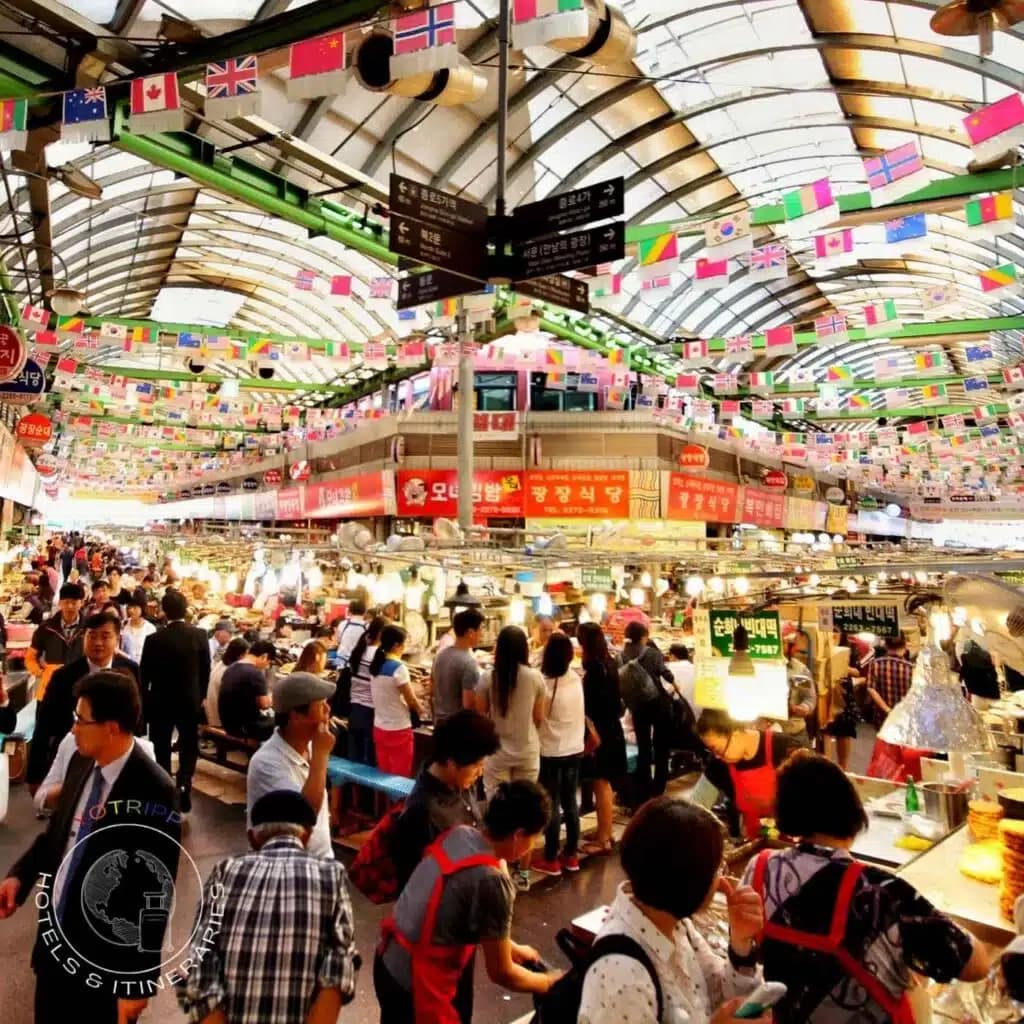

02.
Gwangjang Market Opening Hours, History & Other Details
Pin this to your Seoul Pinterest board so you can find this post easily again.
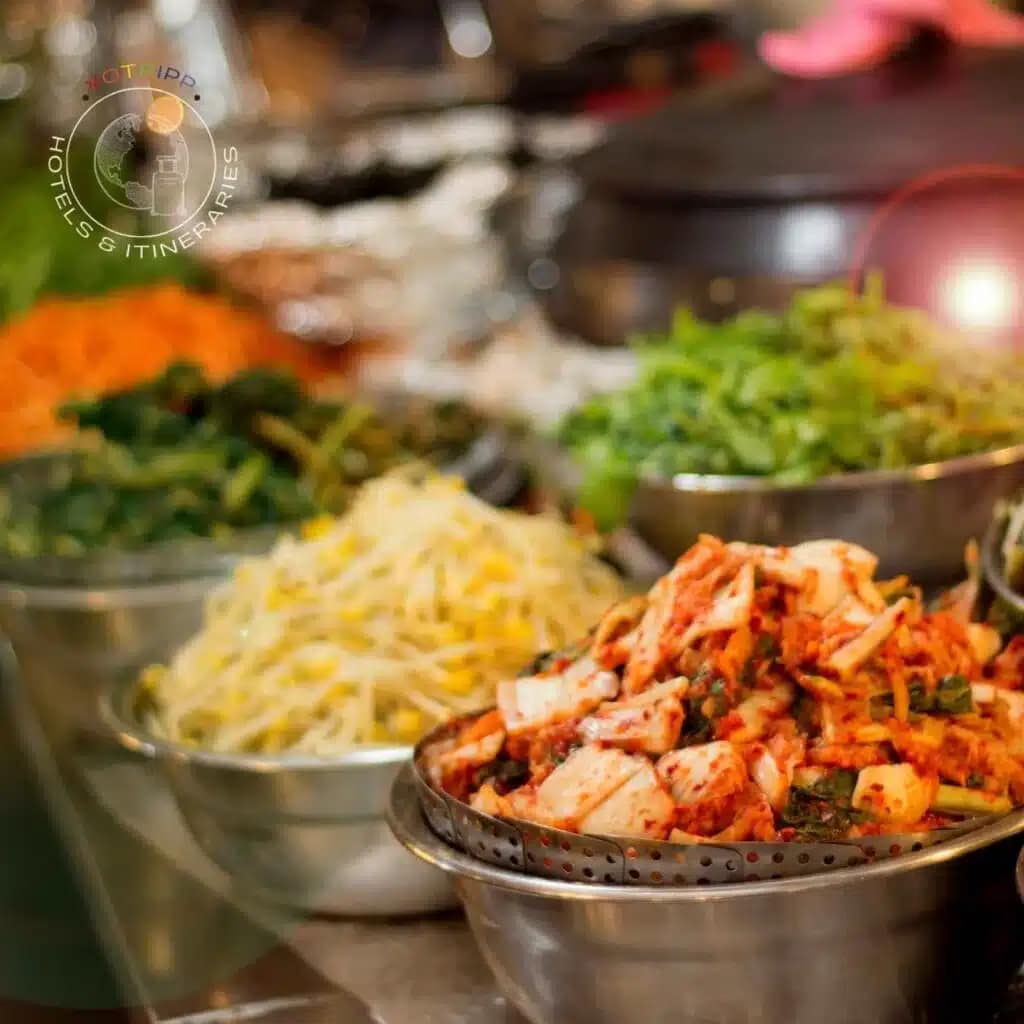
03.
Why Gwangjang Market is Seoul’s Best Food Market?
Well, Gwangjang market isn’t just a food market, to be honest. It is a traditional market that also has vintage, linen and other shops right from souvenirs to jewellery. But this is all on the first floor. You get great bargains here and sometimes you may even come across a unique vintage souvenir to take back home with you.
That said, it is most famous for its food though. Aisles and aisles of food vendors sell different popular snacks here. And this is not just limited to the indoor market area either. If you’re an adventurous traveller, nearly all streets leading up to the market have restaurants and typical street food vendors. All it takes is a little research and a little patience and you’re sure to find that one thing you fell in love with.
If you take a pre-formatted walking food tours of Seoul, you can go straight in to enjoy without the pain of all the research.
Gwangjang market is also a typical fresh vegetable and meat market. On one side of the market, you can buy the freshest of local vegetables and not to mention, the freshest of seafood, some even alive! So all in all, visiting the Gwangjang market is a one-of-a-kind experience for travellers since it combines its culinary adventures with other local experiences that cannot be had elsewhere.
Pin this to your Seoul Pinterest board so you can find this post easily again.

04.
What is the History of Gwangjang Market?
Gwangjang market has a history worth telling too. It was opened in 1905 when hard-working Koreans came together to rebuild their war-torn nation. It started as a marketplace where locals could find something to sell and make a living for themselves and their families. What started like that then, is today a sprawling feature housing over 5000 shops! It is almost impossible to cover it all in one visit.
Pin this to your Seoul Pinterest board so you can find this post easily again.
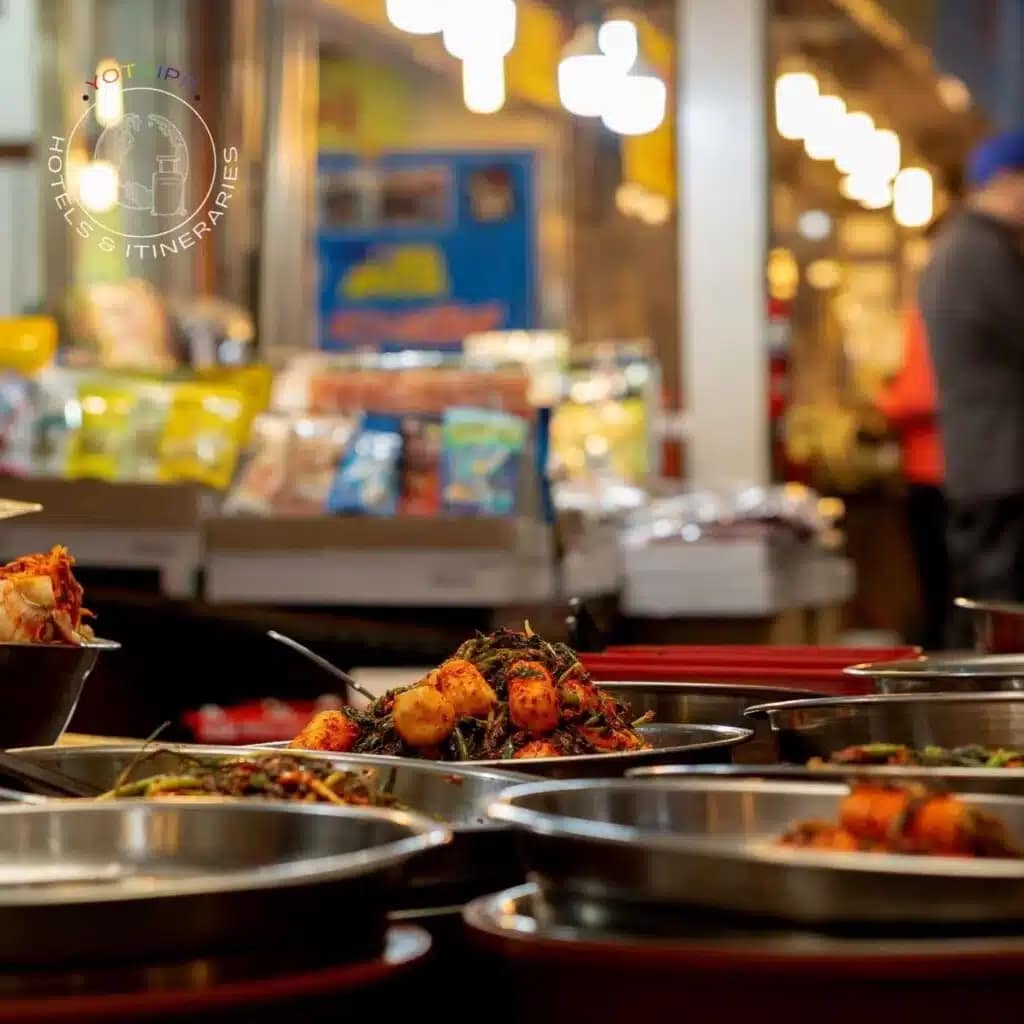
05.
What are the Open Times for Gwangjang Market in Seoul?
Most Seoul Food Markets operate till late at night since they serve cheap dinners not just to frugal travellers but also to budget-conscious locals. Still, different food markets in Seoul operate at different timings and it is best to know them before you head out for a visit.
The Gwangjang market business hours for general shops and vendors are from 8:30 AM to 6:00 PM. Clothing stores generally open at 9:00 AM and stay open till 10:00 PM. Gwangjang market opening hours for food stalls and restaurants are from 8:30 AM till 11 PM.
06.
Where is Gwangjang Market? How do I Get to Gwangjang Market?
Gwangjang Market is located right next to Jongno 5-ga station and is located in the suburb of Jongno-Gu. Since Seoul’s public transport system is a good one, you can get there easily by metro. Metro line 1 gets you to Jongno 5-ga subway station and the easiest way to get to the market (other than sniffing for the aromas) is to get on the street via exit 7 or 8 and then walk South. You can see the market entrance when you take the first right on the street.
07.
How to get to Gwangjang Market from your Hotel in Seoul?
Seoul’s public transportation system is awesome. No matter where you are in Seoul, use connecting subways to get on a station on the metro Line 1 route and then catch the metro line 1 subway to Jongno 5-ga Station. Once you disembark at Jongno 5-ga, come out to street-level through Exit 7 or 8.
Walk south along Dongho-ro and take the first right. The entrance to the market will be straight ahead. Alternatively, you can hop on to lines 2 or 5 and disembark at Euljiro 4-ga Station via exit 4 and then take a shuttle from there.
08.
How to go From Seoul Station to Gwangjang Street Food Market?
If you’re wondering how to get to Gwangjang Market from Seoul Station, you have the option of taking the metro or hopping on the green line bus. Seoul Metro runs between Seoul Station and Jongno 5-ga every thirty minutes and costs under USD2 (KRW 1,250 – 1,400) per ticket. The journey from Seoul Station by metro takes about 9 minutes. If you have a Discover Seoul Pass that’s loaded with T-money, you can use it on the Seoul Metro to get to the market from Seoul Station.
If you plan on taking the Seoul Green Circulating Bus from Seoul Station Transfer centre, catch the one that runs operates every 20 minutes and heads out to Euljiro 4-ga. This journey is longer but will cost you just about a dollar or under.
Alternatively, since the distance between Seoul Station and Gwangjang Market is just over 2kms, you can take a leisurely walk and work up an appetite.
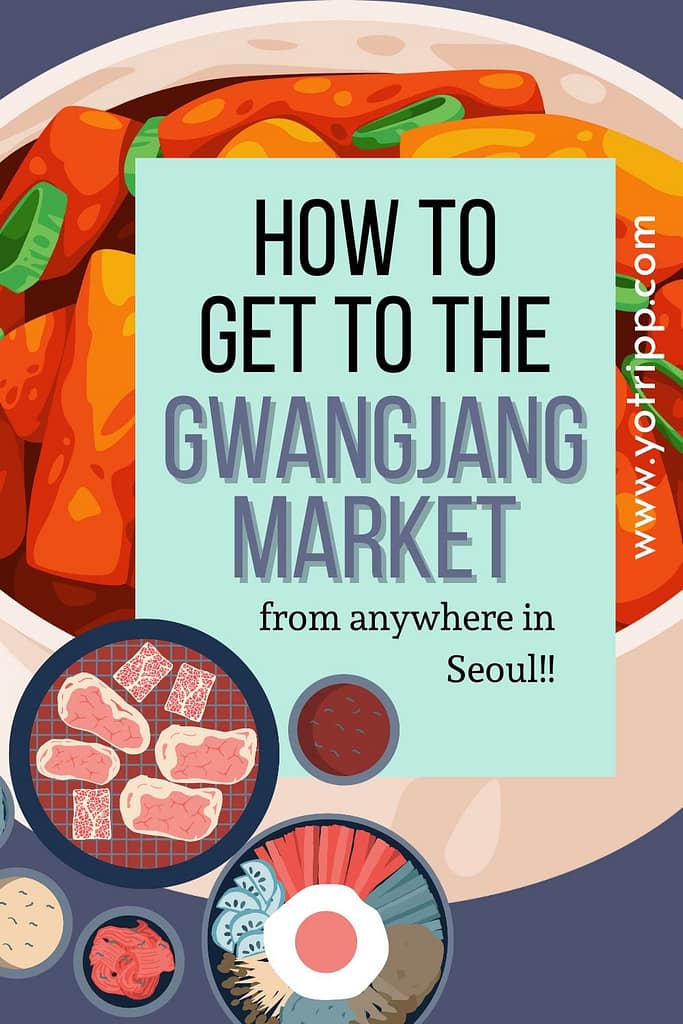
Pin this to your Seoul travel board!
09.
How to go from Myeongdong to Gwangjang Market?
If you’re wondering how to get to Gwangjang Market from Myeongdong, you have options even in metro lines. The easiest way to cover the 2km distance though is to take the subway from Myeongdong Station to Dongdaemun Station (4 Light Blue) and then take line 1 from Dongdaemun Station to Jongnp 5-ga Station. the journey takes about 25 minutes and costs about KRW 2,400 – 2,700.
If you plan on making your way to this market on foot, you can plug in the following address on your phone’s GPS: 88, Changgyeonggung-ro, Jongno-gu, Seoul.
When you plan your visit to Gwangjang market and you intend to use public transport to get back to the hotel later, pay close attention to your time. Subway in Seoul closes at midnight and you may want to not the last train timing at your entry and exit points before you make your plans. Taxis in Seoul are expensive, especially so when it is after hours.
The Gwangjang Market is open during Chuseok. But if you have queries regarding Gwangjang Market’s opening times and closing time during Chuseok or Seollal, you can talk to a Gwangjang market guide or enquire directly on the following hotline.
1330 Travel Hotline: +82-2-1330 (Korean, English, Japanese, Chinese)
10.
How Expensive is Gwangjang Market?
Gwangjang Market is the perfect place for frugal travellers who are looking to explore Seoul on a budget. Especially since Seoul has such a thriving street food culture, culinary tourism features heavily on any good Seoul itinerary. Gwangjang Market is the perfect solution for travellers who wish to make the most of their food adventures, without spending an arm and a leg on food alone.
Food at Gwangjang Market is significantly cheaper than food in other areas of Seoul. You can get a good filling meal here for anywhere between KRW 5000 to 10,000. If you looking to snack on some delicious and local street food, you can get individual items anywhere between KRW 1000 to 3000 even.
11.
When Should You go to Gwangjang Market and Other FAQs?
Gwangjang market is active and alive throughout the day. It is busy almost all through the day, all through Monday to Saturday (though it is slightly, very slightly, quieter on weekdays than weekends). Gwangjang Market is open on Sundays, especially in the food market section. But many food stalls are closed and it may not give you the traveller a full experience of the market’s hustle and bustle if you go there on a Sunday.
Also, here are some of the things to know before you go to Gwangjang Market.
- As typical food markets are in Asia, the market has uneven walking surfaces. The market is really big too. So wear comfortable walking shoes, preferably closed shoes since the floor may even be dirty or wet.
- Carry cash with you. Many vendors here offer a discount if you make cash payments instead of using your cards.
- The market’s official website mentions that the market is largely accessible. That said, it is important to note that the market is extremely busy and not all food stalls have accessible seating. Getting around in the crowds may be difficult for the differently-abled. The market is busy and bustling. Food is served fast and vendors are often screaming all around to get more visitors to their stalls. In a way, the market serves quick Korean fast food, so travellers are not expected to linger and hold up seats without ordering. The usual turnaround time is 20 minutes or so.
- Though the Gwangjang market is huge and has thousands of vendors, almost everyone (barrings a few novelties) serves the same food, albeit made with different ‘secret’ ingredients. It is almost impossible to know the best street foods to try in Gwangjang Market by the name of a vendor or by looking up someone on the Gwangjang market map. Just find a reasonable crowded one and sit down. The trick is to know that if a place is popular with the locals, it must have good food (wink wink).
- If you do not want to explore Gwangjang or any other Seoul food markets on your own, you can book a culinary tour, a food-centric walking tour or pair up with a knowledgeable local to get the best food and travel experience of Seoul.
- One more thing to know before you go to Gwangjang market (or rather before you go to this traditional food market) is that once you are done enjoying the food, you must make time to take a walking tour of Gwangjang market. Be sure to check out the first-floor bounty, especially satin and silk products, traditional Korean hanboks and more.
- Once you’re done enjoying the Gwangjang market, you can make a complete day tour out of it by visiting the nearby Jongmyo Shrine, a UNESCO world heritage site, and other nearby Seoul attractions.
- Lastly, if you’re wondering whether you should visit the Gwangjang market as a vegetarian or a vegan, the answer is a big yes. Granted that good options for vegetarians and vegans at Gwangjang market are decidedly limited to a few items such as hotteok (sweet pancake), the sights, sounds and atmosphere is genuinely something every tourist should experience in Seoul. It is a true look at Korean culture.
- Gwangjang market is a very tourist-friendly place. Almost everywhere there are English boards and signages and so getting about with poor knowledge of the Korean language is not that hard. The stall vendors also speak some broken English and that’s enough to get by without too many troubles.
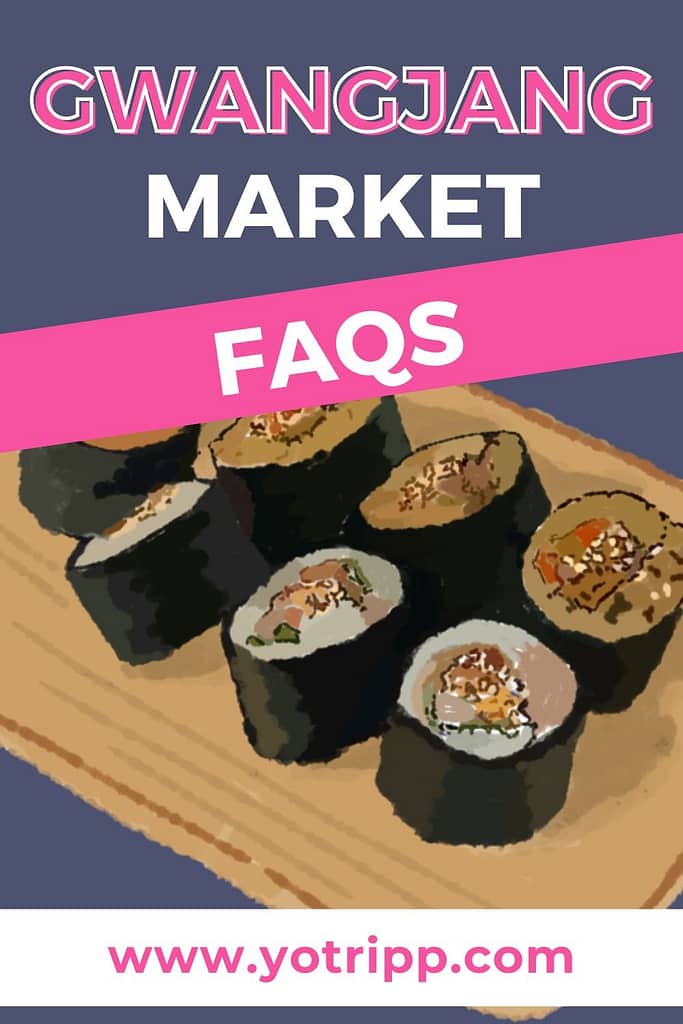
Pin this to your Seoul Pinterest board so you can find this post easily again.
12.
What to Eat at Gwangjang Market? What Foods Must I Try at the Gwangjang Market?
Finally, we’ve hit the food section wherein I’ll give you a complete list of best and weird street foods to try at Gwangjang Market. If you ask me the question, what to eat at Gwangjang Market though, I’ll say, all of the Korean street foods listed below.
Be brave when you explore Korea through its food. As Seoul’s street food hot-spots go, it does not get bigger than this. That said though, it is perfectly okay to not be quite that brave either. For example, it is perfectly understandable if as a tourist if you wish to skip a taste of San-nakji (live octopus tentacles). Of course, that takes a different kind of brave (and a different kind of steely stomach).
So, let’s dive right in and look at some of the best street foods of Gwangjang Market.
13.
Korean Mixed Rice: Gwangjang Market Bibimbap
As Korean foods go, this is not only one of the more common ones but also one of the most filling and satisfying (and did I mention, my favourite). It is almost always a part of Seoul walking food tours no matter which food market you choose to explore.
Bibimbap is served as white sticky rice with meat and assorted veggies, all drenched in a delicious Korean gochujang sauce (Korean red pepper sauce), soy sauce and sesame seeds. It is also topped with a slightly runny egg.
Granted that the bibimbap looks best unmixed, but you’ve got to believe me, it tastes divine when mixed. So don’t judge it by its looks!
Traditional bibimbap includes minced beef (but you can easily make a vegetarian-friendly bibimpap at home if you prefer it without the meat as I do), tofu, bean sprouts, shitake mushroom, spinach greens and zucchini. It does not contain any noodles!
What is Bibimbap?
Bibimbap translates to ‘mixed rice’ and the way to eat it is to mix the rice, meat, veggies and the runny egg, well with the spicy sauce and eat it all together as a mixture.
How much does Bibimbap cost at Gwangjang Market?
Bibimbap price at Gwangjang Market: Approximately KRW 5000 (around 4.5 USD).
Where can I eat Bibimbap in Seoul?
Bibimbap is available at almost every stall serving traditional Korean food in the Gwangjang market, including in the famous bibimbap alley within the market.

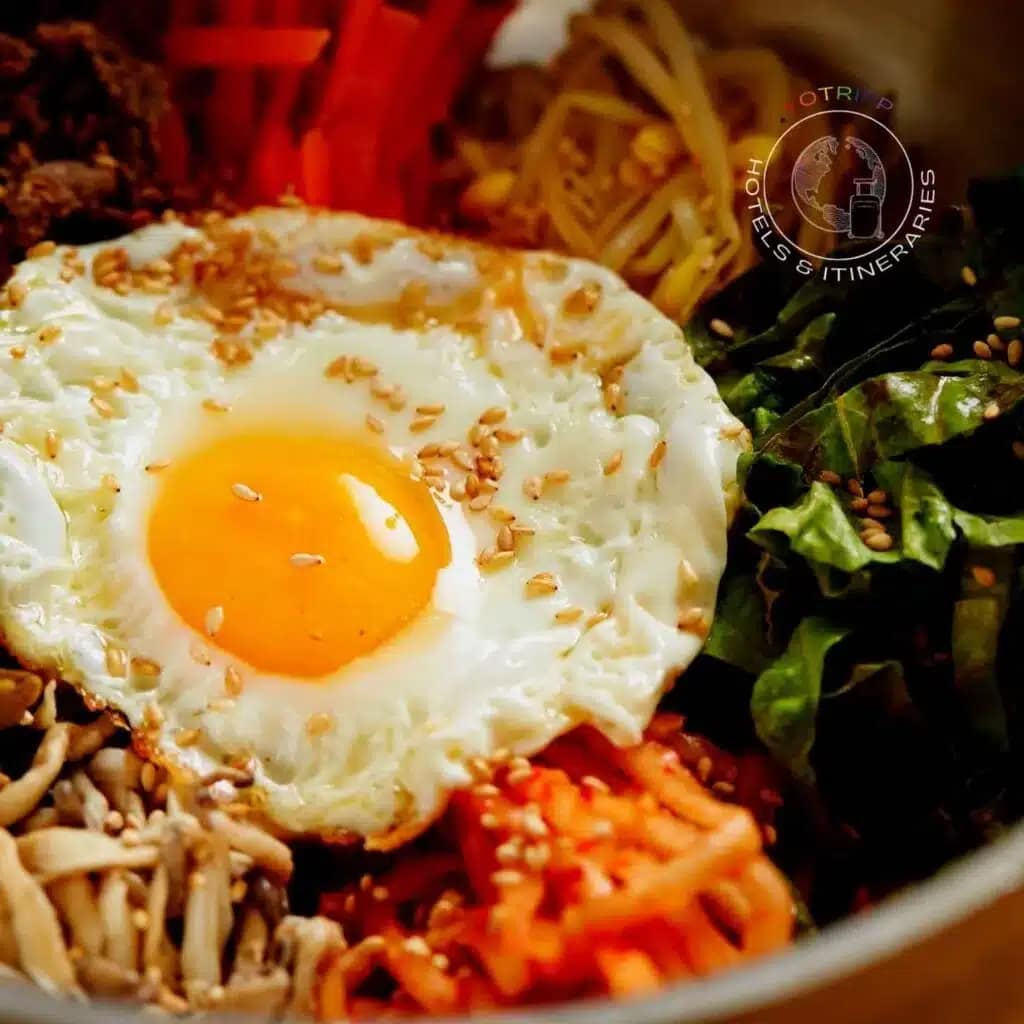
Pin this to your Seoul Pinterest board so you can find this post easily again.
14.
Korean Savoury Pancakes: Gwangjang Market Bindaetteok
One of the many types of Korean pancakes, bindaetteok are deep friend, savoury mungbean pancakes. Apart from ground mung beans (that are soaked overnight), these pancakes contain an assortment of vegetables including green onions, bean sprouts and others, and minced pork.
Bindaetteok is also sometimes known as Nokdujeon. It is served with raw onions drenched in soy and vinegar, a kind of light sauce. And as is the case with almost all traditional Korean foods, you may also get a bowl of kimchi with it.
Granted that the Bindaetteok are fried and oily, but right at Gwangjang market where they are fried hot, hot right before your eyes, these are irresistible and must most definitely be tried. Bindaetteok is a common street food in Seoul and can also be had at other food markets or street stalls.
What is Bindaetteok?
Bindaetteok are Korean mung-bean pancakes. These fried, savoury pancakes also contain vegetables such as green onions, bean sprouts and others, and minced pork.
How much do Bindaetteok cost at Gwangjang Market?
Bindaetteok price at Gwangjang Market is approximately KRW 4000 (around 3.5 USD).
Where can I eat Bindaetteok in Seoul?
Try Bindaetteok at Gwangjang market in Seoul. It is not available at every food stall at Gwangjang market. You will have to walk around the market to find a Bindaetteok vendor to try these delicious and savoury mung bean pancakes.
Is Bindaetteok (mung bean pancake) vegetarian?
Though bindaetteok is called mung bean pancake, it does contain pork. So it is neither halaal nor vegetarian. At least not at Gwangjang market. For a vegetarian-friendly bindaetteok, go to a high-end restaurant that offers these customizations, or make it at home as it hard to find a vegetarian version on any Seoul food tour.
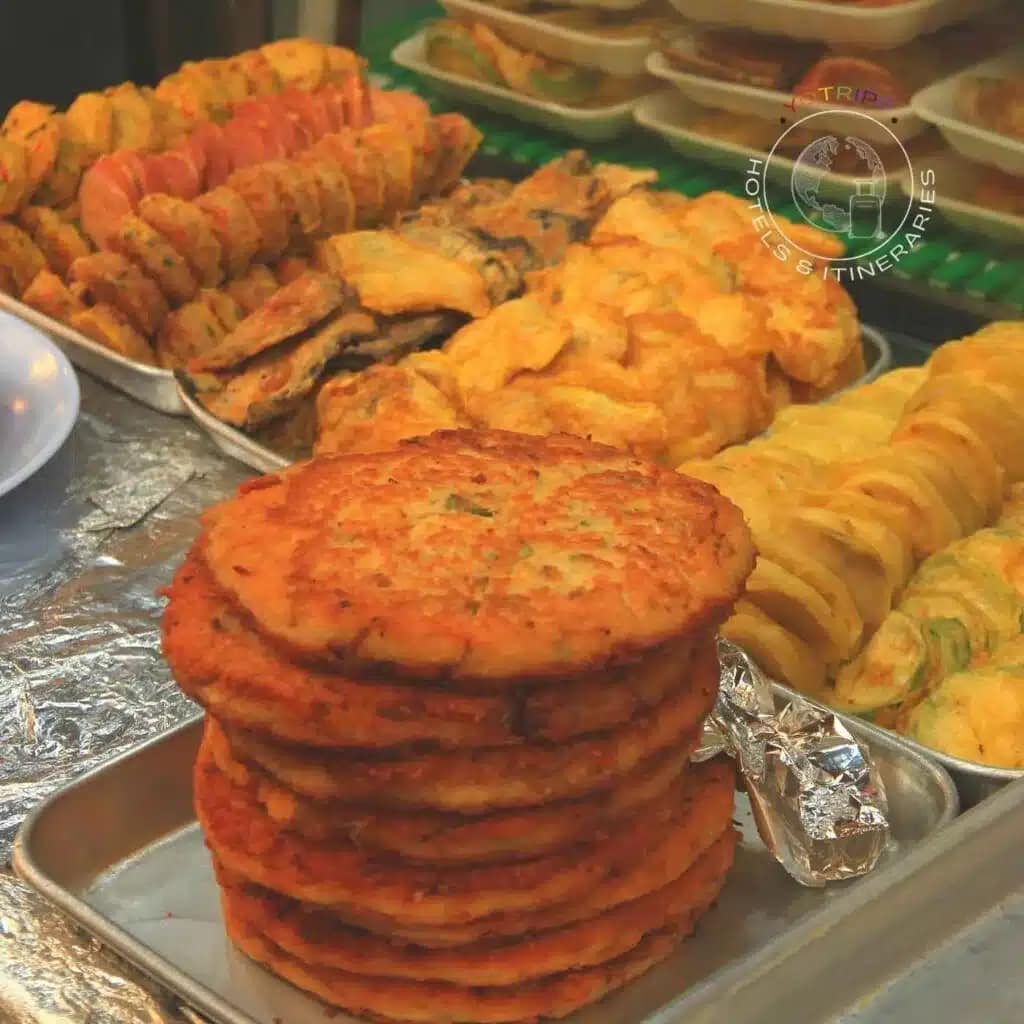
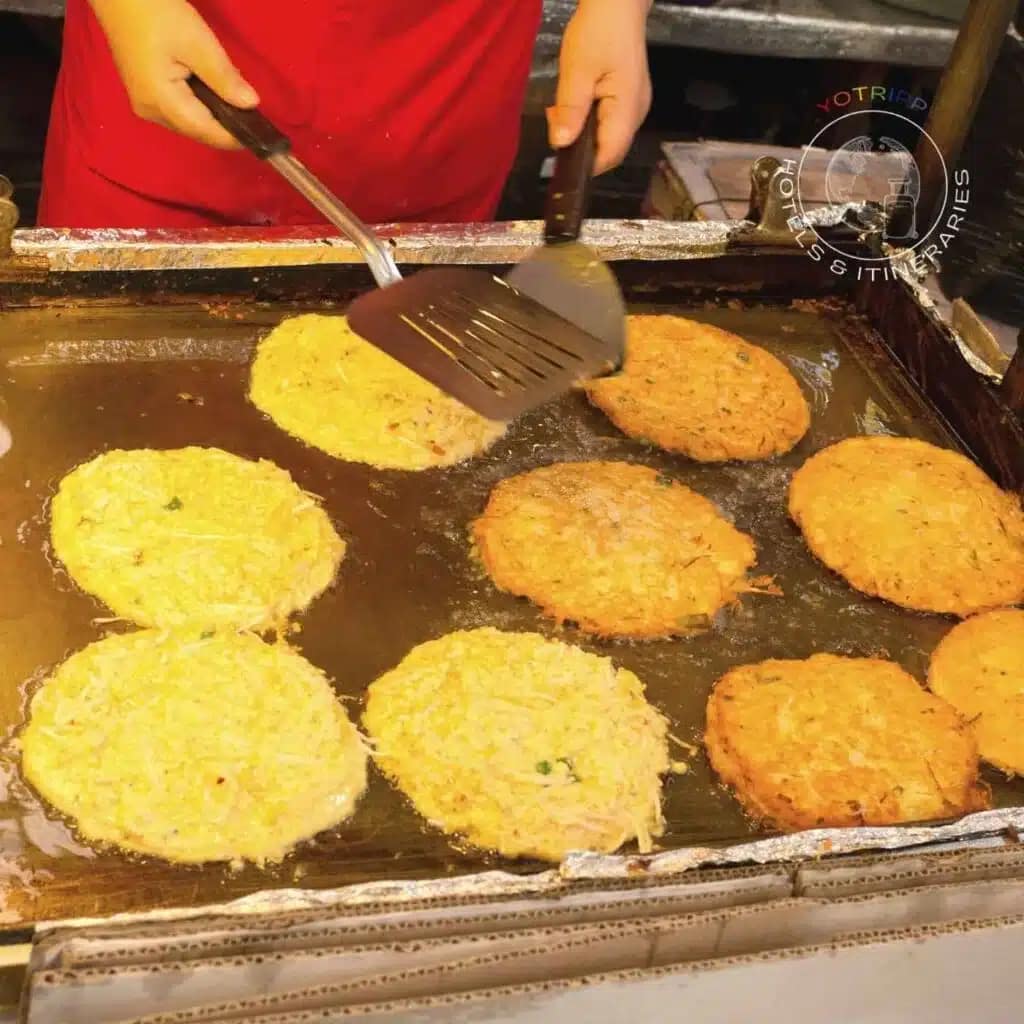
Pin this to your Seoul Pinterest board so you can find this post easily again.
15.
Korean Rolls: Gwangjang Market Mayak Kimbap (Gimbap)
Mayak Kimbap, the Korean version of Japanese maki rolls, is addictive, much-loved street food in the Gwangjang market.
Translated, the word mayak means ‘drug’ and this Korean seaweed and rice roll is seriously addictive, just like drugs.
Mayak Kimbap is made with rice, seaweed, eggs, cucumbers, carrots and radish. These narcotic rolls have a wasabi-like kick since the sushi rice is additionally seasoned with vinegar. There is a clear taste of sesame oil that make these narcotic rice rolls quite distinct in taste.
Mayak Gimbap is truly the go-to food at Gwangjang market and if you must try just one street food here, make it this one.
What is Mayak Gimbap?
Mayak Gimbap (or drug rolls as they are popularly called) are delicious rolls of rice stuffed with vegetables, similar to Japanese maki rolls or sushi.
Is Mayak Gimbap vegetarian?
Mayak Kimbap, or as some call it, Korean sushi rolls, traditionally also have some seasoned meat rolled into them.
Hence mayak kimbap is not vegetarian, vegan or even halal for that matter, since Koreans favour pork. But if you have no such dietary inhibitions, try these seaweed rice rolls, they are that good!
How much does Mayak Gimbap cost at Gwangjang Market?
Mayak Kimbap price at Gwangjang Market is approximately KRW 3000 (around 2.65 USD).
Where can I eat Mayak Gimbap in Seoul?
Mayak gimbap is available at numerous stalls throughout the Gwangjang Market. As it is a specialty at the Gwangjang market, it does not require a lot of searching.
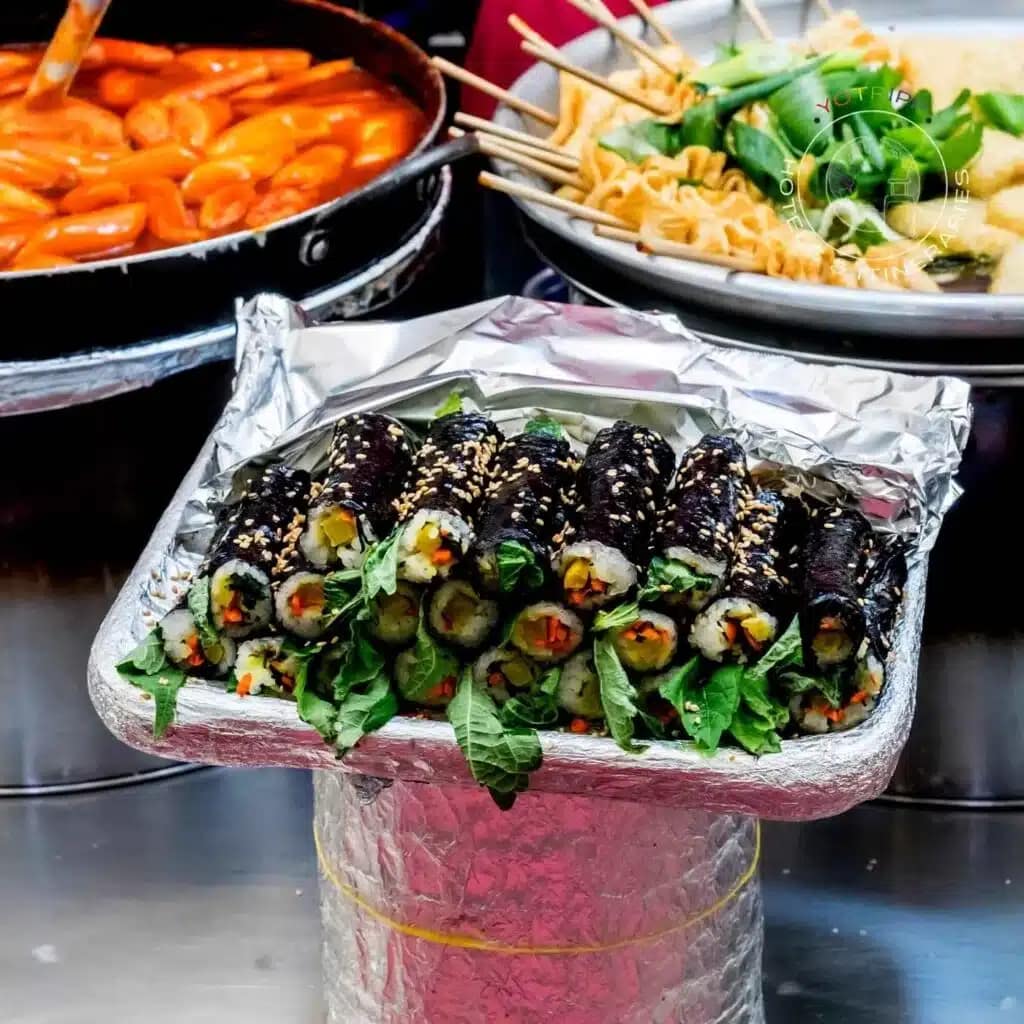
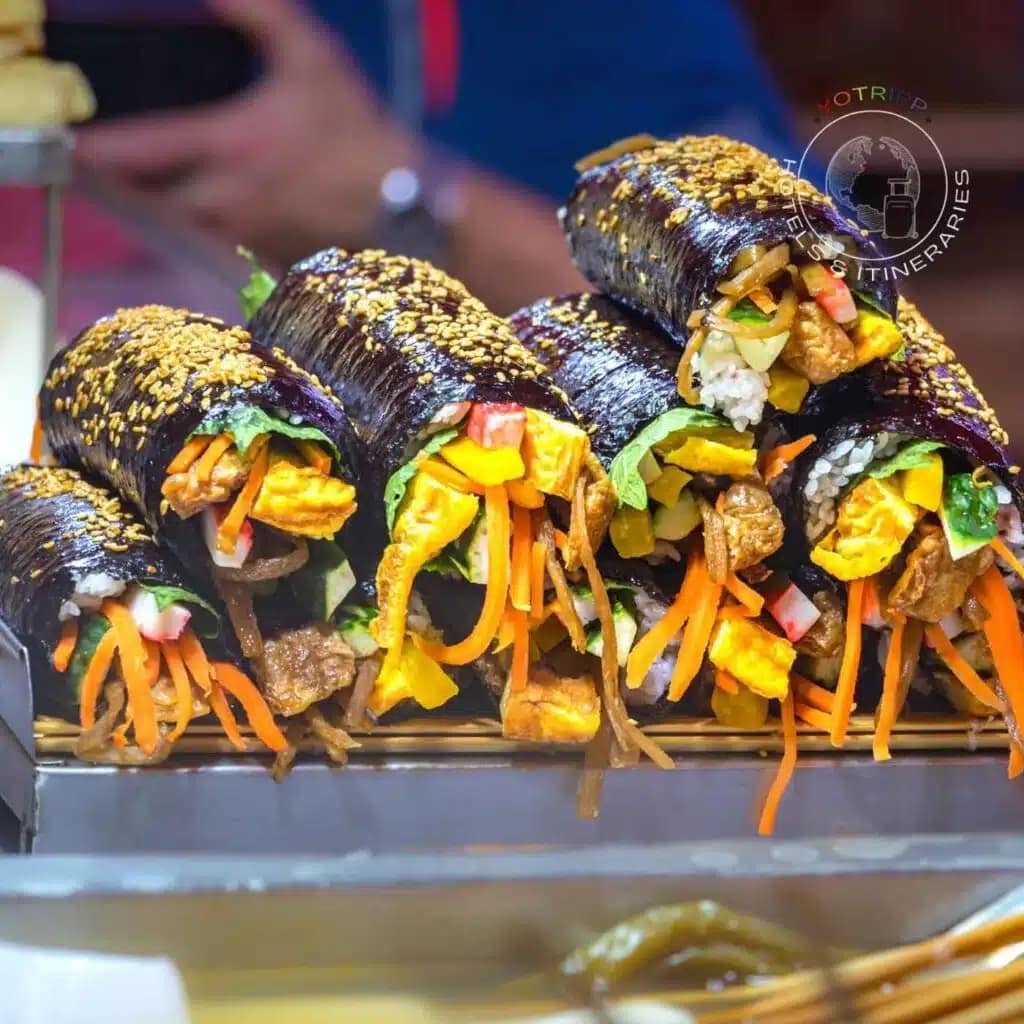
Pin this to your Seoul Pinterest board so you can find this post easily again.
16.
Korean Blood Sausage: Gwangjang Market Soondae or Sundae
Now here’s something not for the faint-hearted, and especially not something considered to be typical or common meats when it comes to Indians at least. Soondae or blood sausage is not just scary to read up on but is equally scary to look at.
You’ll find many stalls in Gwangjang carrying a big, fat and dark looking sausage and that’s blood sausage for you. If you are an adventurous eater, try a Soondae, which is sometimes served sliced up on a perilla leaf (and often with other pig meats such as pig’s ear).
The Soondae is considered a real street food delicacy in South Korea.
What is Soondae?
Soondae are sausages made up of pig’s meat, blood and some mung bean noodles or even some sticky rice. Soondae sausages are typically wrapped up in cow skin. When you order it, the vendor slices up the sausage and steams it. It is then seasoned with chilli and salt before serving.
How much does Soondae cost at Gwangjang Market?
Soondae prices at Gwangjang Market are approximately KRW 10000 (around 8.84 USD).
Where can I eat Soondae in Seoul?
Soondae are difficult to miss at Gwangjang Market in Seoul. Look for counters where they are serving various sausages and the blood sausage will most likely be right there on display, upfront and prominent.
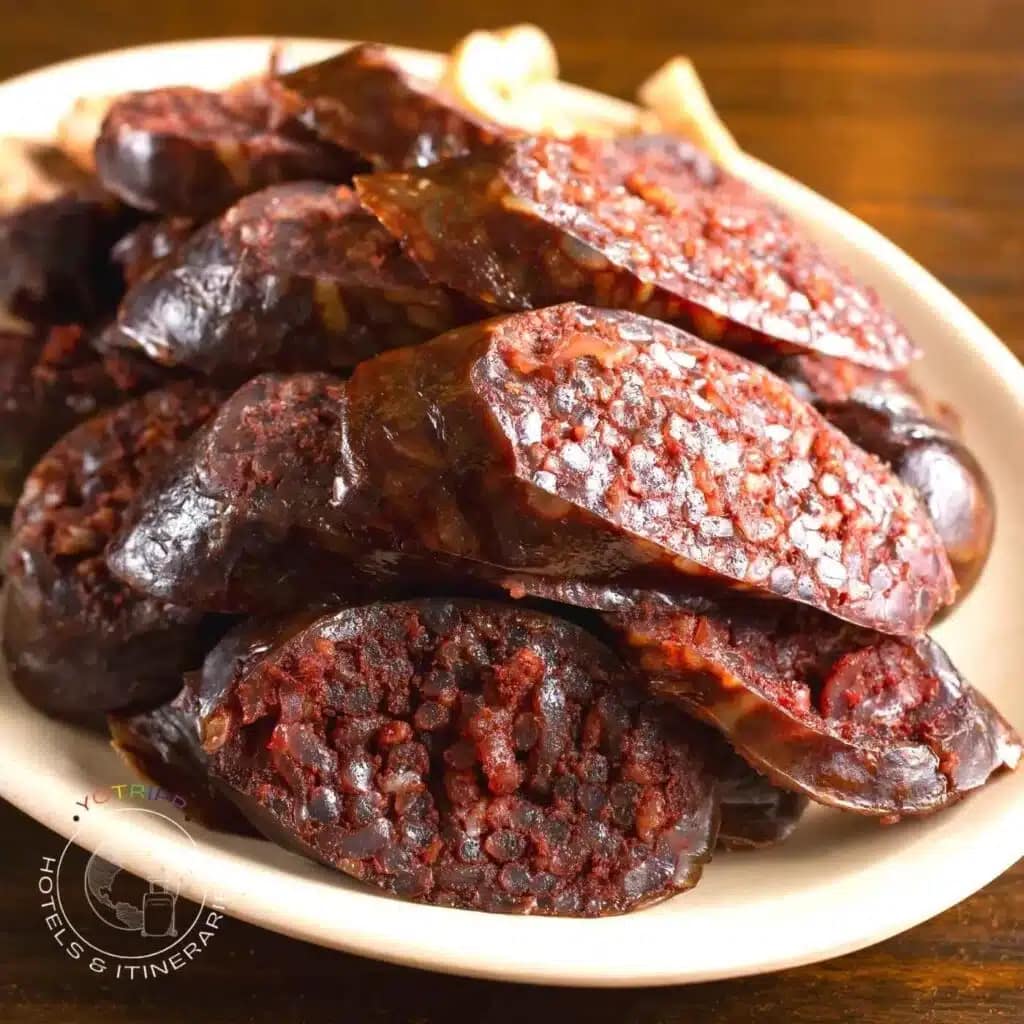
Pin this to your Seoul Pinterest board so you can find this post easily again.
17.
Korean Rice Rolls / Rice Cakes: Gwangjang Market Tteokbokki
Tteokbokki is another really common Seoul street food and a lot of stalls at Gwangjang offer these delicious but spicy rice rolls or rice cakes.
But Tteokbokki as a dish involves cooking these rice cakes in thick, red chilli sauce (gochujang) and stewed on low heat till the flavours get infused in the rice cakes. Tteokbokki is served piping hot, and this makes the heat of the sauce pack quite a punch if you’re not used to spicy foods.
Tteokbokki is served as a spicy, chewy snack but it is nice and filling so can be a meal on its own. It is a favourite with locals.
What is Tteokbokki?
The rice rolls/cakes themselves are just densely rolled-up Korean sticky rice (so densely rolled that you do not see the grains at all). These are then offered steamed or fried on their own as well. Ttteokbokki is a spicy, saucy dish make with these cakes.
Is Tteokbokki vegetarian?
And is Tteokbokki vegetarian, you ask? Though the basic rice cakes are 100 per cent vegan, they come in various flavours so it is impossible to know if the Tteokbokki at Gwangjang market is vegetarian or vegan (or even halal). That said, general Tteokbokki is often cooked with boiled eggs and fish cakes, so if you’re conscious of what you eat, this may be an issue.
How much does Tteokbokki cost at Gwangjang Market?
The price of Tteokbokki at Gwangjang Market is approximately KRW 3000 (around 2.65 USD).
Where can I eat Tteokbokki in Seoul?
Tteokbokki is ubiquitous at Gwangjang Market and you can find it at almost every stall that typically sells kimbap/gimbap.
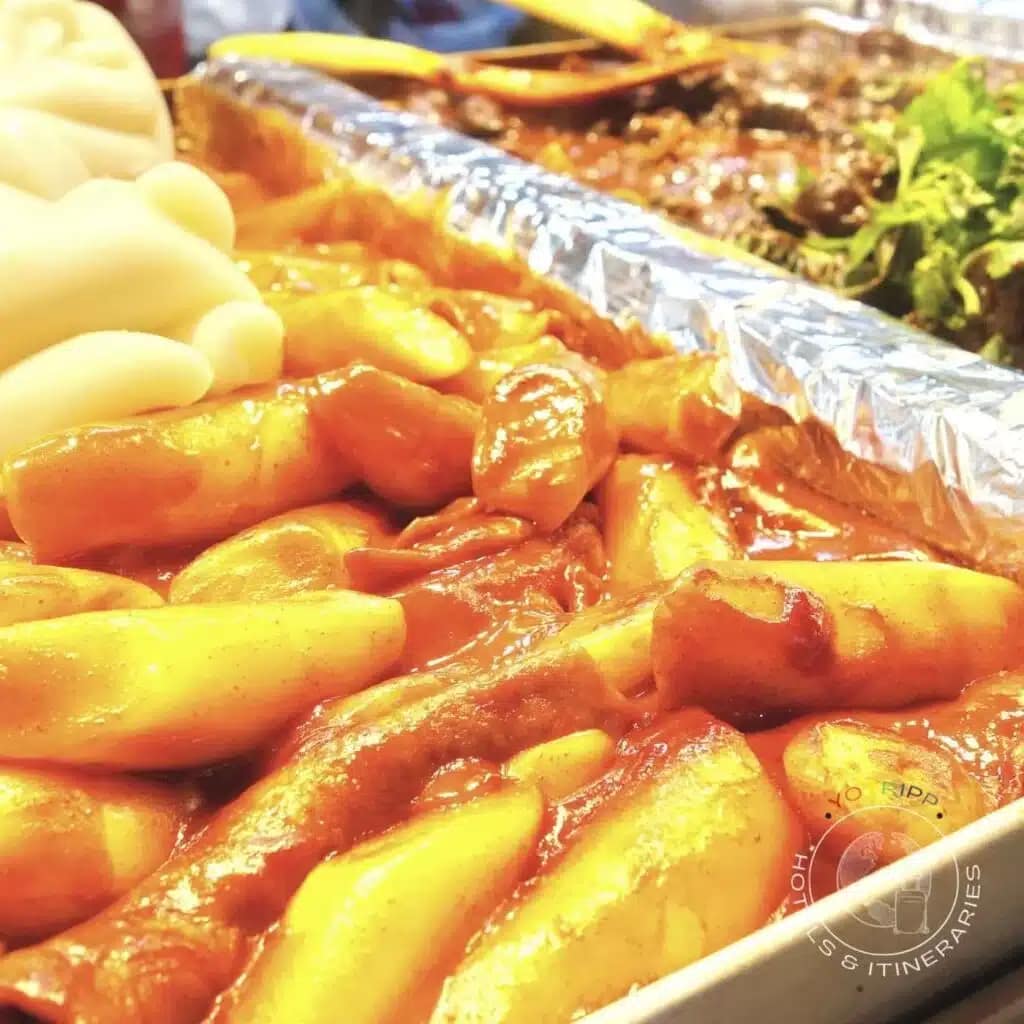
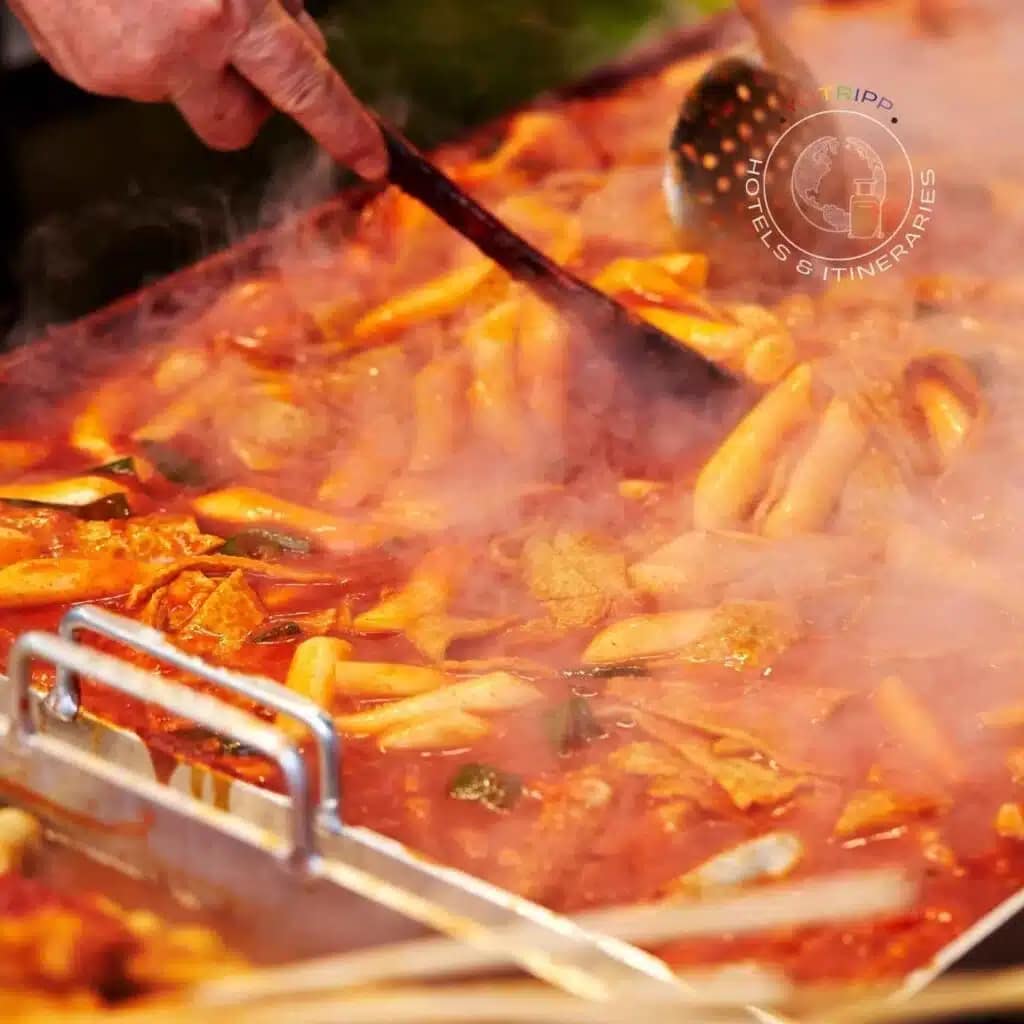
Pin this to your Seoul Pinterest board so you can find this post easily again.
18.
Korean Sweet-Potato Noodles: Gwangjang Market Japchae
Japchae is a delicious Korean sweet-potato noodles dish. The noodles are stir-fried in sesame oil to make for a super snack. This sweet and savoury dish is made from sweet potato starch noodles, which are naturally low fat and low calorie. So Japchae can be considered as a health food since it also contains an assortment of vegetables.
Japchae is also served as a banchan (side dish) with other dishes since it is well-loved and absolutely delicious.
What is Japchae?
Japchae is a sweet and savoury noodle dish made with sweet potato noodles and vegetables. It is often served as banchan, a side dish, at Korean dinners and lunches.
Is Japchae vegetarian?
Along with soy sauce and sesame seeds, Japchae noodles contain fresh greens such as spinach, carrots and shitake mushrooms. Some Japchae versions also contain beef or pork but usually, Japchae is vegetarian food, as even listed by PETA.
How much does Japchae cost at Gwangjang Market?
Japchae price at Gwangjang Market is approximately KRW 3000 (around 2.65 USD).
Where can I eat Japchae in Seoul?
Japchae is ubiquitous at Gwangjang Market and you should have no difficulty in finding a stall that serves these hot or cold Korean noodles.
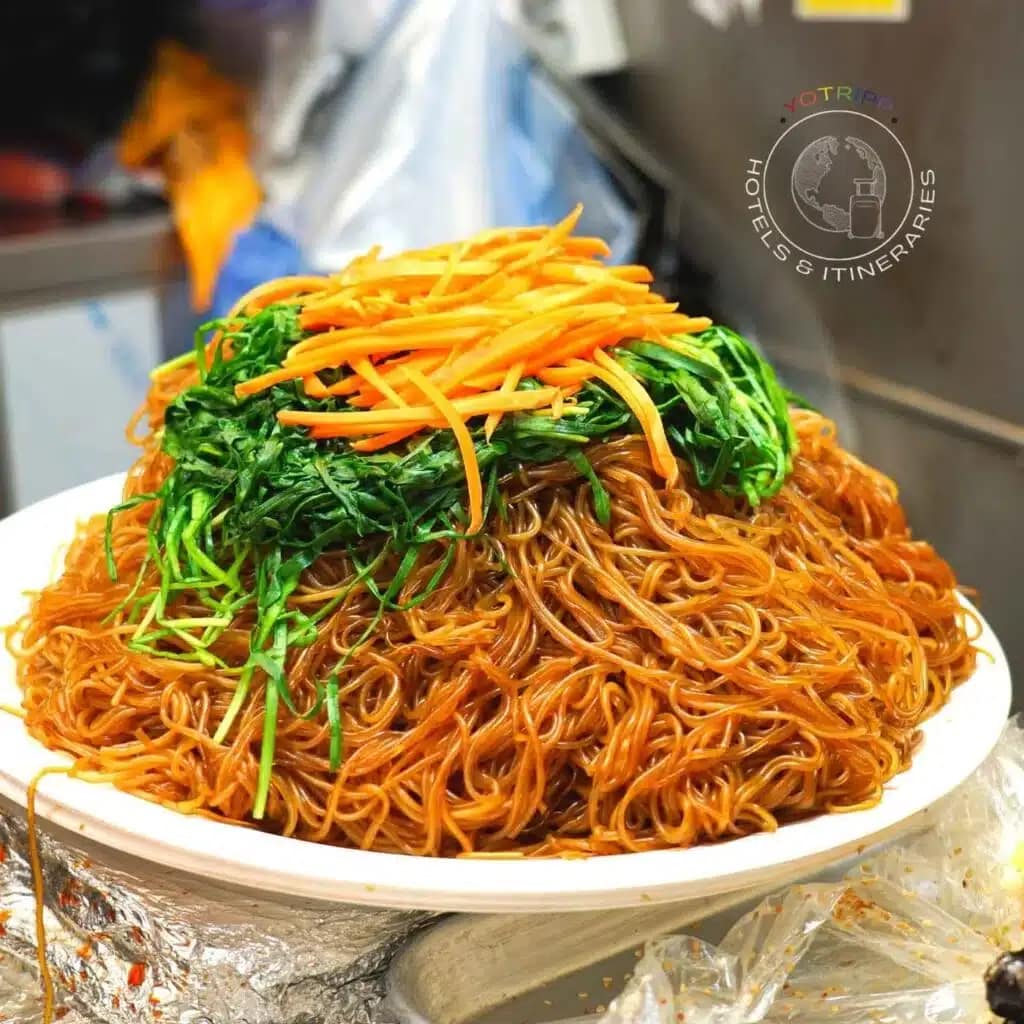
Pin this to your Seoul Pinterest board so you can find this post easily again.
19.
Korean Hand-Cut Noodles: Gwangjang Market Kalguksu
Kalguksu is a light and refreshing Korean noodle soup that came in limelight thanks to Netflix’s Street Food episode on Seoul’s Gwangjang food market. Kalguksu is made with hand-cut wheat flour noodles. The long strands of these tagliatelle-type noodles may need to be cut with a pair of scissors if you are new to having them with chopsticks.
The noodles are served in a large bowl of light broth, like Japanese udon, topped with seaweed and assorted vegetables. The broth is light but made with chicken or seafood such as dried anchovies, shellfish and kelp.
What is Kalguksu?
Kalguksu us a light, broth-y soup containing hand-cut noodles. Kalguksu has recently got a fair share of limelight thanks to Netflix’s Street Food show.
Is Kalguksu vegetarian?
Kalguksu, traditionally a summer ramen-style soup, is considered a hearty meal that is light on digestion. Due to the obvious ingredients that flavour the broth, even though Kalguksu may appear to be vegetarian at first glance, it isn’t.
How much does Kalguksu cost at Gwangjang Market?
Kalguksu or Kal-guksu costs appproximately KRW 5000 (around 4.41 USD) at Gwangjang Market.
Where can I eat Kalguksu in Seoul?
Kalguksu is served at several places in Gwangjang market, however, if you wish to try the most famous vendor (featured on the Netflix show) find the Gwangjang Market Netflix lady Yoon Sun Cho’s famous and popular stall. You can’t miss it, she has a big Netflix board right on top of her stall.
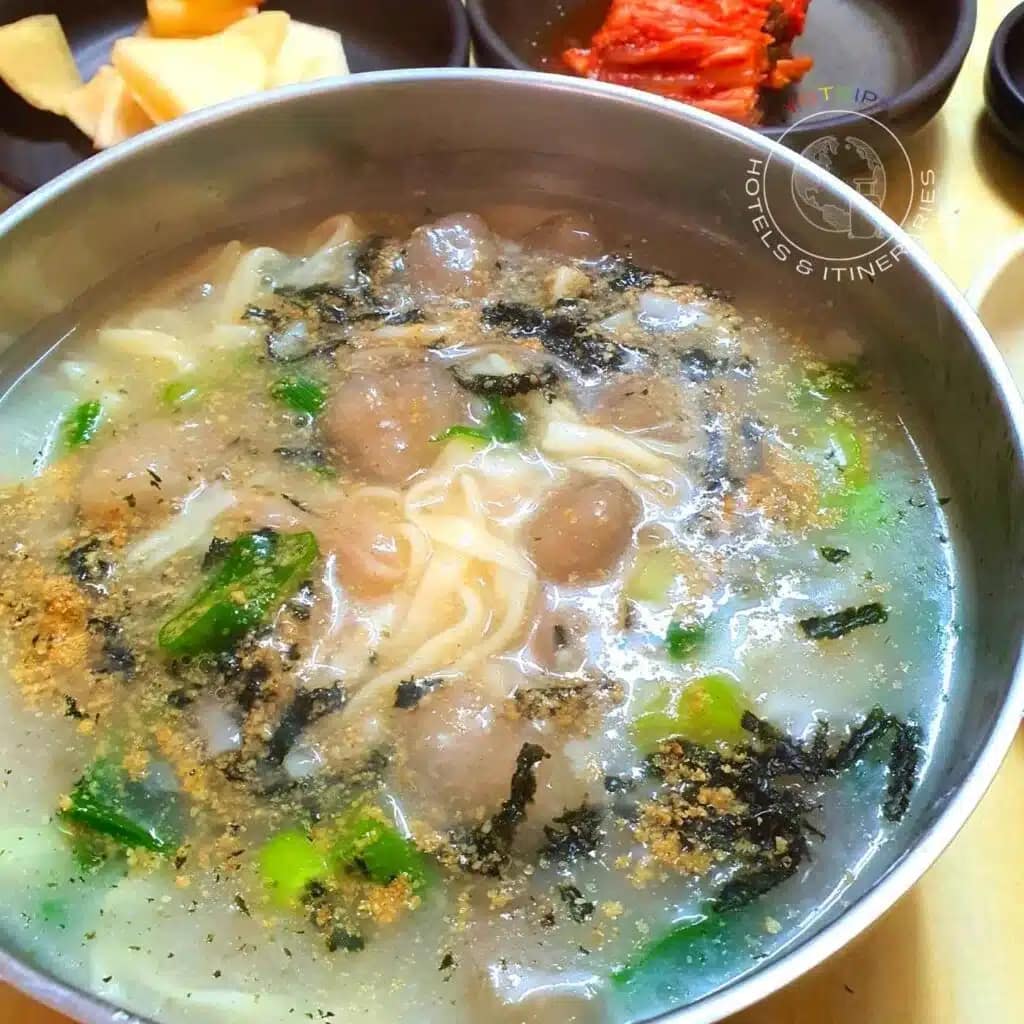
Pin this to your Seoul Pinterest board so you can find this post easily again.
20.
Korean Sweet Pancake: Gwangjang Market Hotteok
Hotteok or hoeddeok is a type of Korean sweet pancake made from Korean glutinous rice. This popular Seoul street food is often filled or stuffed with brown sugar syrup or sunflower seeds or both. Due to the use of yeast, hotteok tastes a little bit like bread even though it is clearly a rice pancake.
Hotteok is a popular winter snack and when eaten piping hot it is delicious, gooey, and sweet. It is crisp on the outside due to being fried on a skillet and soft and gooey on the inside. If you love sweet snacks, this street food is a must-try one for you.
What is Hotteok?
Hotteok is a sweet, stuffed pancake that is made of rice. It is a popular winter snack in Seoul, and it is served and eaten while piping hot.
How much does Hotteok cost at Gwangjang Market?
Hotteok costs between KRW 2000 to 3000, that’s just under 3 USD, at the Gwangjang street food market.
Where can I eat Hotteok in Seoul?
Hotteok is a popular Gwangjang market food and hotteok stalls are impossible to miss here. Just follow the aroma and find a vendor who is pressing balls on an oiled skillet.
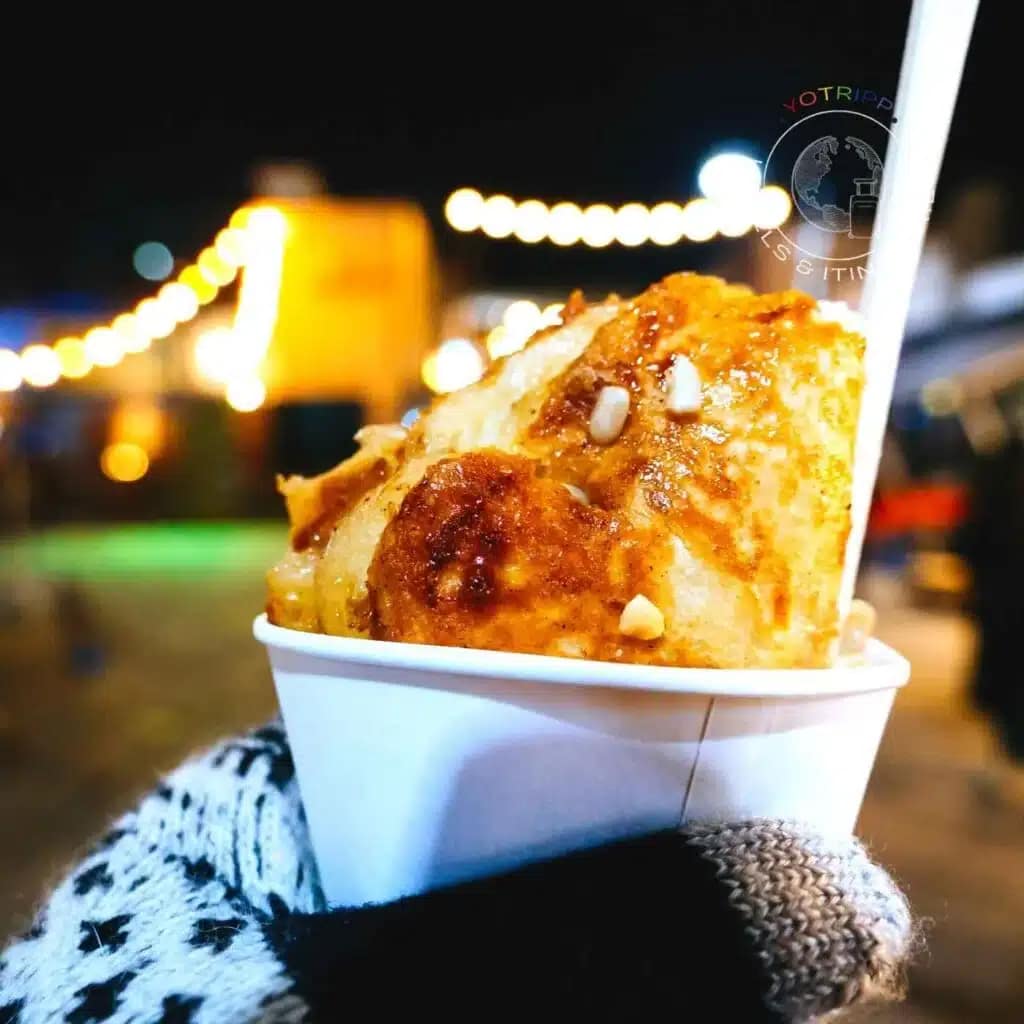
Pin this to your Seoul Pinterest board so you can find this post easily again.
21.
Korean Version of Chinese Dimsum: Gwangjang Market Mandu
Mandu is a Korean steamed dumplings dish that comes with different stuffings, such as kimchi dumplings, beef or pork dumplings.
Though these dumplings are mostly steamed, you may even find vendors that offer them pan-fried or deep-fried. These dumplings are flavoured with soy sauce and sesame oil. They may also contain assorted vegetables.
The meat dumplings are often slightly bland when it comes to spice but the kimchi dumplings are truly spicy, especially so when you eat them hot. If you aren’t used to spice, try the kimchi ones with caution.
What are Mandu?
Mandu are stuffed dumplings similar to Chinese dimsum.
Are Mandu vegetarian?
Mandu are stuffed with meat, such as pork, beef, etc and are hence not vegetarian. Kimchiu mandu as the name suggests, is a mandu stuffed with kimchi. Though kimchi seems harmless enough when you look at the main ingredients it may not always be vegetarian.
Is Kimchi vegetarian?
You can make vegetarian kimchi. There are several recipes for that. However, the kimchi available at food markets in Seoul, is most probably not vegetarian despite the main ingredients being vegetables such as cabbage and radish. This is because shrimp paste and fish sauce is added to kimchi to make it more flavourful here.
How much does a plate of Mandu cost at Gwangjang Market?
A plate of Mandu at Gwangjang Market will cost you about KRW 3000, or just over 2.5 USD.
Where can I eat Mandu in Seoul?
Mandu is quite ubiquitous in the Gwangjang market. Many vendors offer it and you’ll find it beautifully displayed on the counters themselves. The reddish ones are filled with kimchi while the white-ish ones are usually filled wit meat such as pork.
Mandu is served with a dipping sauce containing soy sauce and a dash of vinegar. If you love momos or other Chinese, Turkish or Japanese dumplings, you’ll love mandu.
It is important to note that though the kimchi mandu appear to be vegetarian, traditional kimchi may contain fish sauce and so it may not necessarily be so.
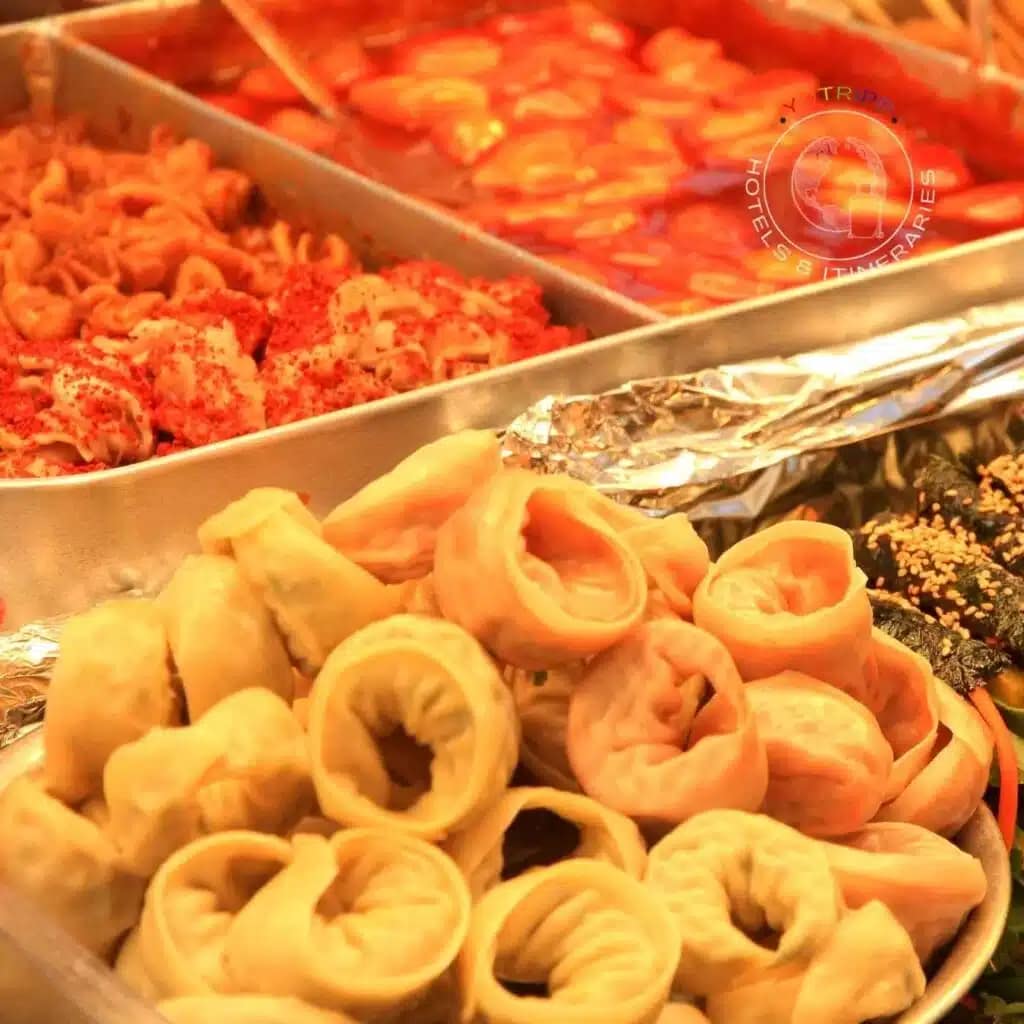
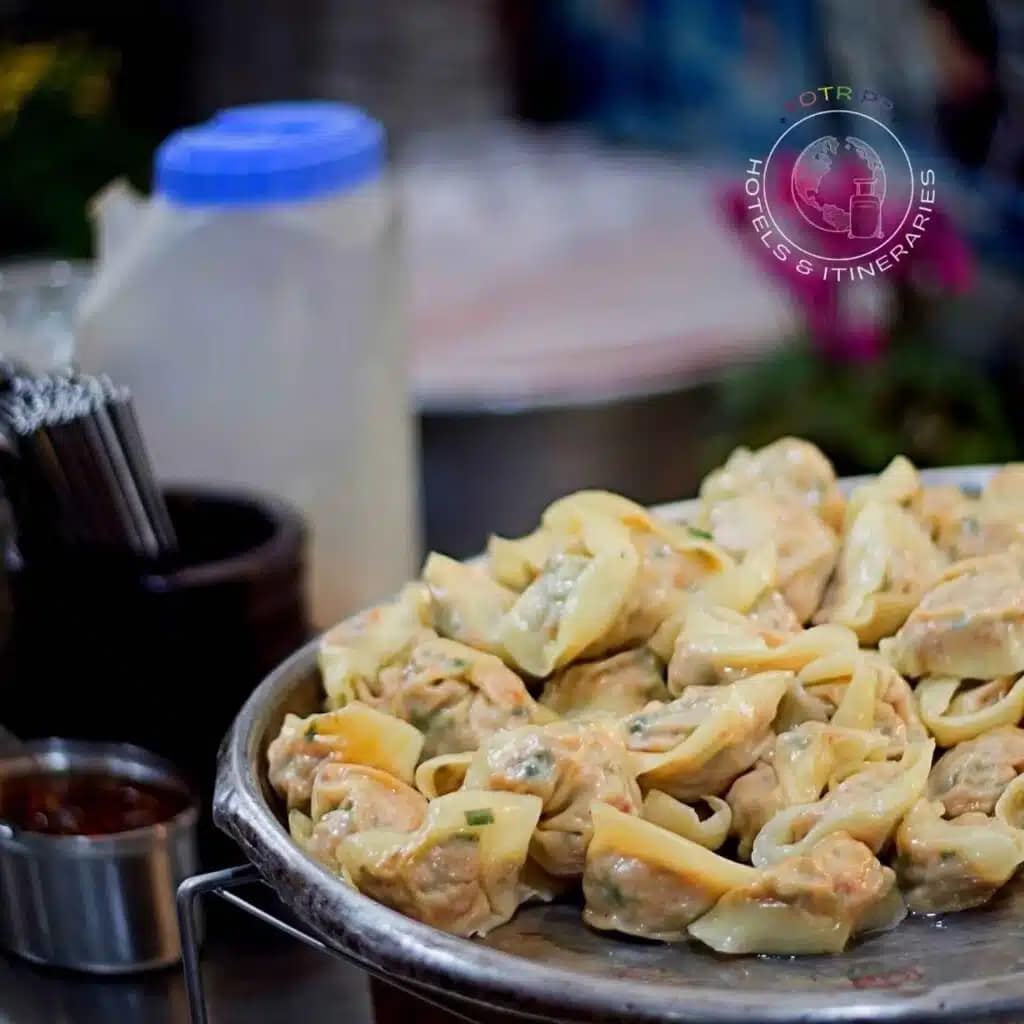
Pin this to your Seoul Pinterest board so you can find this post easily again.
22.
Korean Fish Cakes: Gwangjang Market Odeng / Eomuk
If you pictured cakes as something like a traditional cake, you’ll have another thought coming on you see and taste Korean odeng or eomuk. These fish cakes are often seen on the streets of Seoul, sold on skewers. They are delicious and staple.
Odeng is made with surimi, a type of fish paste that’s then mixed with flour, carrots, onions and other seasonings. The flour is thus kneaded, folded and then shaped into the serpentine fish-cakes you see on skewers, so easy to find in Gwangjang market. These cakes can be boiled or steamed, or in some cases even fried.
Odeng at Gwangjang market is served with a warm, light fish broth.
What is Odeng?
Odeng are Korean fish cakes that are served on skewers.
How much do Odeng cost at Gwangjang market?
At Gwangjang market street food stalls, Odeng skewers cost between KRW 1000 to 2000 (under 1 USD).
Where can I eat Odeng in Seoul?
Odeng is not difficult to find, neither inside the Gwangjang market nor at other street food markets in and around Seoul since it is common and popular.
.
.
Other Street Foods to Try At Gwangjang Market
.
Korean Donuts: Gwangjang Market Chapsal / Chapssal
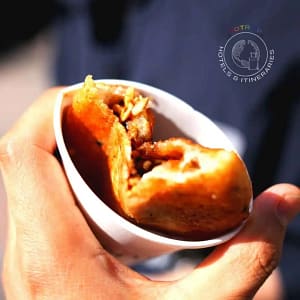
Chapssal is another kind of stuffed glutinous rice doughnut found at Gwangjang market. Unlike traditional doughnuts, chapssal are not made with refined white flour.
This mildly sweet doughnut is stuffed with sweetened red bean paste, something delightfully unique to Korean food.
Similar to the chapssal is buneoppang. You can also try the buneoppang at Gwangjang, which is a fish-shaped pastry also filled with sweetened red bean paste (or sometimes Nutella).
Chapssal is also available in a twisted doughnut form and these are called kkwabaegi.
Chapssal Price at Gwangjang Market: KRW 1000 (under 1 USD)
.
Korean Steak Tartare: Gwangjang Market Yuk Hoe
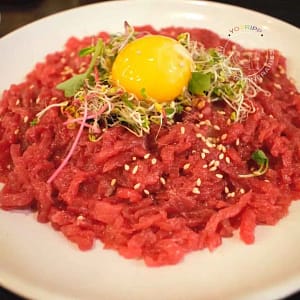
There is a raw beef alley at Gwangjang market (Gwangjang market yukhoe alley) and if you are looking for some gourmet food at Gwangjang market, you must try Yukhoe (steak tartare) at Bukchon, a Michelin recommended visit (2018).
The establishment is tucked in at one of the corners of the raw beef alley and is open daily from 9 AM to 11 PM.
Buchon Yukhoe has been around since 1965 so you can savour that little bit of history while you’re there. Be prepared to shell out a lot more money though because yukhoe is expensive, especially in comparison to other street foods available at Gwangjang.
Yukhoe cost at any of the stalls in Gwangjang Market’s Raw Beef Alley: Appromixately KRW 12,000 (just under 11 USD) but it could even cost you around 20,000 KRW.
.
Korean Beef Tacos: Gwangjang Market Bulgogi
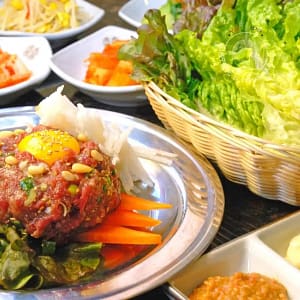
Bulgogi is simply put, marinated slices of beef or pork cooked on a barbecue to give it a mild smoky flavour. It is eaten with rice and/or vegetables.
Korean gochujang sauce gives bulgogi that distinct sweet and spicy taste.
Depending on the types of meat chosen and the manner in which the bulgogi is served (especially whether it is a prime cut or not), the cost of bulgogi changes drastically.
Your bulgogi at Gwangjang market can cost you anywhere between 1200 won to 12000 won!
.
Korean Grilled Meat: Gwangjang Market Galbi
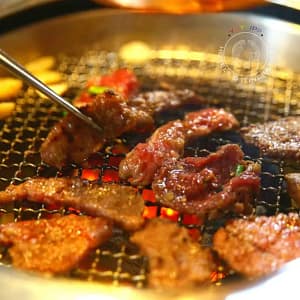
Kalbi or Galbi is another type of grilled meat. Galbi or galbi-gui are simply beef short ribs or pork spare ribs grilled to perfection.
It is often served with a variety of pickled side dishes (banchan) and Korean soy-based sauce.
Galbi is a well-loved meal in South Korea even at restaurants and for at-home celebrations.
Dak Galbi at a restaurant costs about KRW10,000 but the same at Gwangjang market is of course significantly cheaper.
.
Korean Baked Rice Dish: Gwangjang Market Baffle
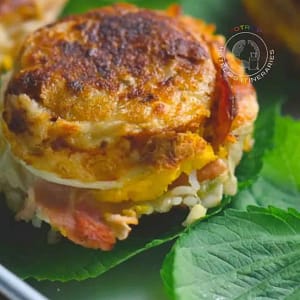
The Baffle is a modern take on Korea’s basic traditional foods. It is a popular baked rice dish that is appetising to look at and delicious to eat.
The Baffle, which is a play of words between baked and waffle, is topped with an egg and served on a perilla leaf.
Baffles, a modern take on traditional Korean foods, was made famous thanks to a Netflix street food documentary, and what was once an uncertain experiment is today a successfully integrated street food.
A baffle costs you around 4000 KRW at Gwangjang market.
.
Korean Spicy Raw Crabs & Soy Marinated Crabs: Gwangjang Market Gejang
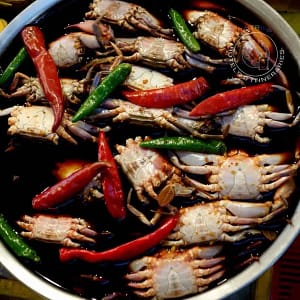
Gejang is made by marinating fresh (and often live) crabs in Korean ganjang (soy sauce). You can even try the spicier version of the same dish with the crabs are marinated in a spicy, chilli-powder based sauce. Gejang is considered a speciality at the Gwangjang market.
Soy-marinated crabs were featured on the same Netflix documentary that was mentioned previously. If you’d like to sample these delicious, melt-in-mouth crabs, you can head over to the same stall mentioned in the documentary, Honglim Banchan Stall.
It is important to note though, that these crabs are eaten raw. so if you are not into raw seafood, it is best to avoid them.
At an upscale restaurant, these crabs would cost you about KRW 35,000 per serving, but at Gwangjang they are much cheaper and are served per one-crab-serving.
.
Spicy Pig Trotters: Gwangjang Market Jokbal
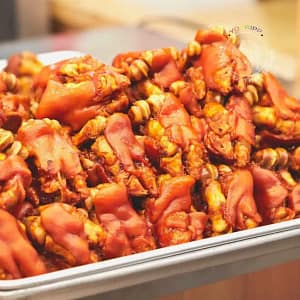
These are quite a sight when you come across them at Gwangjang market. Jokbal is spiced pig trotters marinated in soy sauce and then later braised in rice wine along with some vegetables and spices.
Jokbal is a popular street snack in Korea and is it is served with an equally delicious shrimp sauce that works as a perfect umami compliment to the jokbal’s sweet-ish caramel-y taste.
Jokbal goes really well with local Korean liquor as well.
Jokbal (braised pig trotters) costs between KRW16,000 to KRW 20,000 depending on the portion size.
.
Stir-Fried Chicken Feet – Gwangjang Market Dakbal
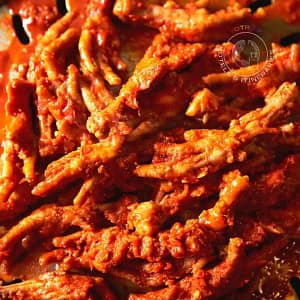
Similar to Jokbal, Dakbal is chicken feet. Except, at Gwangjang market, they are deboned first and then deep-fried after being coated with a batter of flour and eggs.
Since the feet are deboned first, the pieces are entirely chewable.
This fiery hot anju (evening) snack is often had with Korean alcoholic beverages, kind of like the chimaek combination of fried chicken and beer.
.
Korean Tempura Squid: Gwngjang Market Ojingeo Twigim
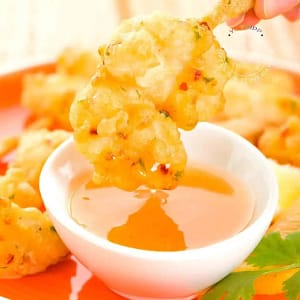
To put it simply, Ojingeo Twigim is what westerners know as calamari or to put it more precisely, it is tempura squid of deep-fried squid. Sounds yum already, doesn’t it?
.
Korean Rice Wine: Makgeolli
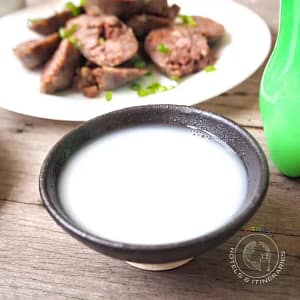
While Korean soju is so well known inside and outside Korea, makgeolli is a lesser-known but widely popular, local rice wine.
It is light and tastes a little sweet, and the best part, it goes well with some of the spicier offerings of the Gwangjang Market.
Makgeolli may not be found at a specific stall in Gwangjang Market but it is a social drink offered at regular street food stalls so all you need to do is ask if your stall has it.
.
Korean Rice-Based Drink: Sikhye
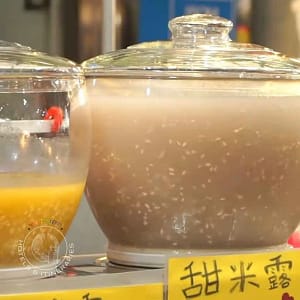
The Sikhye is a popular rice-based drink that’s available in the Gwangjang market for approximately KRW 1000 (0.8 USD) a glass.
It is a light and refreshing drink that’s slightly sweet, just sweet enough to help you wash down some of Gwangjang’s spicier offerings.
The Sikhye comes in different colours and flavors, and we say, try them all, why not?!
.
Korean Live Octopus: Sannakji / San-nakji

Eating live octopus tentacles might not be everyone’s cup of tea but it is certainly a delicacy in Korea. In Gwangjang market’s live seafood section, you can try Sannakji or live octopus tentacles if you have the stomach for it.
.
Korean Green Onion Pancakes: Pajeon
Pajeon is scallion pancakes. They are made by mixing thinly sliced green onions into a batter of eggs, wheat and rice flours and some meat, namely beef, pork or seafood. Sometimes, kimchi is added to the batter or kimchi is served on the side.
South Korea offers a variety of jeon (pancakes). For vegetarians, there is the vegetable jeon which is made with onion, carrots and cabbage. You also get seafood jeon and kimchi jeon at Gwangjang market.
Korean Fish Hotdogs: Hot Bar or Eumokba
This popular street food is a fish hotdog that’s served on a skewer. It is a popular food and is easy to associate with hotdogs due to ingredients like cheese and sausage.
Korean Octopus on a Stick: Nakji Gguri
As Korean stick street food goes, this is by far the most interesting one. When you order nakji gguri, you get a Japanese-inspired, lightly grilled octopus flavoured with various sauces served quite literally on a stick.
And if you’re fond of Korean stick foods, you can also try the dakkochi or Korean chicken on a stick, which is just a skewered chicken and green onion kebab.
Korean Tornado Potatoes: Hoeori Gamja

One of the more modern street foods of Korea, tornado potatoes are simply deep-fried potato swirls served on a stick and seasoned with spices (often ramen seasoning).
.
Korean Deep Fried Popcorn Chicken in Cup: Dakgangjeong
Dakgangjeong consists of deep-fried chicken nuggets tossed in a sweet chilli sauce, often with rice cakes and potato wedges, and garnished with sesame seeds. It is served in a cup and is filling enough to be a meal.
.
Korean Egg Bread: Gyerangbbang
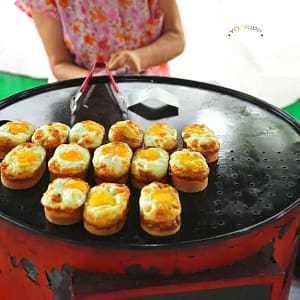
Somewhat similar to the English muffin and egg combo is Korea’s gyerang-bbang or egg bread. This popular winter food is quite simply bread topped with egg.
Though it is served in different variations and combos too, like a sandwich combo where the egg is in between two pieces of bread, or as a sandwich with meats.
This is often found sold by vendors that also sell Korean pancakes.
.
Korean Rice Cake Skewers: Tteokkochi
The rice cakes used in this dish are the same ones used in the tteokbokki dish. The main difference is that here the rice cakes are either lightly pan-fried or nicely deep-fried and then coated with a spicy, sweet and sour sauce before being served on a skewer stick.
That was it about Seoul’s delicious street food experiences, the best of the best available at Gwangjang Market. If you take any essential Seoul city tour or a gourmet tour of Seoul, whether it is a walking tour or otherwise, a visit to Gwangjang shopping centre and food market is almost a must, since the street food stalls here part of Seoul’s attraction and charm. If you visit Seoul, a visit to the Gwangjang market address of 88 Changgyeonggung-Ro, Jongno-Gu is a must!
But instead of visiting it from somewhere far away, you can also choose a hotel nearby and visit it throughout your Seoul trip. So it is now time to look at some popular hotels nearby that give the best access not just to this market and its vicinity but also to other Seoul food markets such as Dongdaemun Market
00.
Some Seoul Hotels Near Gwangjang Market
Tong Tong Petit Hotel
Tong Tong Petit Hotel, at walking distance from Gwangjang Market, is located in Jongo-Gu, hardly 200 metres from the tops Seoul attraction of Jongmyo Shrine. Compare prices for Tong Tong Petit Hotel here. Check availability here.
Cheonggye Haus Hotel
Cheonggye Haus is another excellent hotel in Jongno-Gu and it is located next to Cheonggyecheon Stream, just 150 meters from Gwangjang Market. Compare prices for Cheonggye Hous here. Check availability here.
Hostel Tommy
If you’re looking for a convenient and cheap hostel in Seoul, Hostel Tommy is just 800 metres from Gwangjang Market. The hostel is a 3-minute walk from Jongno 3-ga stations exit number 7 (or exit 8). That’s super advantageous since Jongno 3-ga subway station runs 3 subway lines, line 1, line 3 and line 5. Compare prices for Hostel Tommy here.
There are several excellent hotels near Gwangjang market. Find a hotel in Jongno-Gu or Dongdaemun (near Dongdaemun Market). Myeongdong as a neighbourhood also provides excellent and fast travel connectivity to Gwangjang market so you can consider a hotel here as well. If you do not wish to explore any of these Korean markets on your own, visit a Seoul guided walking tour office and check for guided walking tours or food tours that have an established Gwangjang Market itinerary.
Tripadvisor has some great hotels near Gwangjang Market, just click the banner below and start hunting for the best hotel deals in Seoul. Alternatively, Trip Korea has some great discounted hotels deals for Seoul, that you can check out too.
To recap, do visit this street food market in Seoul. It is truly a historical and cultural heritage. It is sacrilege to leave without checking out the food market itself, the fresh produce morning market alleys, the fruit stores, hanbok shops (Korean costumes) and even the nearby department stores, not to mention meet the super-friendly shop owners. Just one trip here and you’ll be ready to write travel blogs about vintage clothing and buckwheat noodles!
Now for some Gwangjang Market FAQs
Where is Gwangjang Market?
Gwangjang Market is located right next to Jongno 5-ga station and is located in the suburb of Jongno-Gu. Metro line 1 gets you to Jongno 5-ga subway station and the easiest way to get to the market is to get on the street via exit 7 or 8 and then walk South. You can see the market entrance when you take the first right on the street.
How to get to Gwangjang Market from Anywhere in Seoul?
Seoul’s public transportation system is awesome. No matter where you are in Seoul, use connecting subways to get on a station on the metro Line 1 route and then catch the metro line 1 subway to Jongno 5-ga Station. Once you disembark at Jongno 5-ga, come out to street-level through Exit 7 or 8.
Walk south along Dongho-ro and take the first right. The entrance to the market will be straight ahead. Alternatively, you can hop on to lines 2 or 5 and disembark at Euljiro 4-ga Station via exit 4 and then take a shuttle from there.
How to go to Gwangjang Market from Seoul Station?
If you’re wondering how to get to Gwangjang Market from Seoul Station, you have the option of taking the metro or hopping on the green line bus. Seoul Metro runs between Seoul Station and Jongno 5-ga every thirty minutes and costs under USD2 (KRW 1,250 – 1,400) per ticket. The journey from Seoul Station by metro takes about 9 minutes. If you have a Discover Seoul Pass that’s loaded with T-money, you can use it on the Seoul Metro to get to the market from Seoul Station.
If you plan on taking the Seoul Green Circulating Bus from Seoul Station Transfer centre, catch the one that runs operates every 20 minutes and heads out to Euljiro 4-ga. This journey is longer but will cost you just about a dollar or under.
Alternatively, since the distance between Seoul Station and Gwangjang Market is just over 2kms, you can take a leisurely walk and work up an appetite. How to go from Myeongdong to Gwangjang Market?
If you’re wondering how to get to Gwangjang Market from Myeongdong, you have options even in metro lines. The easiest way to cover the 2km distance though is to take the subway from Myeongdong Station to Dongdaemun Station (4 Light Blue) and then take line 1 from Dongdaemun Station to Jongnp 5-ga Station. the journey takes about 25 minutes and costs about KRW 2,400 – 2,700.
If you plan on making your way to this market on foot, you can plug in the following address on your phone’s GPS: 88, Changgyeonggung-ro, Jongno-gu, Seoul.
What are the Timings for Gwangjang Market in Seoul?
Most Seoul Food Markets operate till late at night since they serve cheap dinners not just to frugal travellers but also to budget-conscious locals. Still, different food markets in Seoul operate at different timings and it is best to know them before you head out for a visit.
The Gwangjang market business hours for general shops and vendors are from 8:30 AM to 6:00 PM. Clothing stores generally open at 9:00 AM and stay open till 10:00 PM. The market’s food stalls and vendors, and its restaurants open at 8:30 AM and remain open till 11 PM.
When you plan your visit to Gwangjang market and you intend to use public transport to get back to the hotel later, pay close attention to your time. Subway in Seoul closes at midnight and you may want to not the last train timing at your entry and exit points before you make your plans. Taxis in Seoul are expensive, especially so when it is after hours.
The Gwangjang Market is open during Chuseok. But if you have queries regarding Gwangjang Market’s opening times and closing time during Chuseok or Seollal, you can talk to a Gwangjang market guide or enquire directly on the following hotline.
1330 Travel Hotline: +82-2-1330 (Korean, English, Japanese, Chinese)
Is Gwangjang Market Expensive?
Gwangjang Market is the perfect place for frugal travellers who are looking to explore Seoul on a budget. Especially since Seoul has such a thriving street food culture, culinary tourism features heavily on any good Seoul itinerary. Gwangjang Market is the perfect solution for travellers who wish to make the most of their food adventures, without spending an arm and a leg on food alone.
Food at Gwangjang Market is significantly cheaper than food in other areas of Seoul. You can get a good filling meal here for anywhere between KRW 5000 to 10,000. If you looking to snack on some delicious and local street food, you can get individual items anywhere between KRW 1000 to 3000 even.
When Should You go to Gwangjang Market?
Gwangjang market is active and alive throughout the day. It is busy almost all through the day, all through Monday to Saturday (though it is slightly, very slightly, quieter on weekdays than weekends). Gwangjang Market is open on Sundays, especially in the food market section. But many food stalls are closed and it may not give you the traveller a full experience of the market’s hustle and bustle if you go there on a Sunday.
What to Eat at Gwangjang Market?
Some foods to try at Gwangjang Market are bibimbap, tteokbokki, bindaetteok, mayak gimbap, soondae, japchae, kalguksu, hotteok, mandu, eomuk, chapssal, yukhoe, bulgogi, galbi, baffle, gejang, jokbal, dakbal, twigim, makgeolli, shikhye, sannakji, pajeon, eomokba, nakji gguri, hoeori gamja, dakgangjeong, gyerangbbang, tteokkochi, and more. More details on each of these are available in the article above.
This is 5000+ words informative post that has been well researched and well compiled, simply to be of value to you and help you in your research before you visit Seoul.
The post also contains a few affiliate links. Think of this as a reward for our hard work. While you’re under no obligation to make any purchases, if you do make purchases using our links, you can get the same products at no additional cost, while we make small commissions. So we’d be oh so grateful.
.
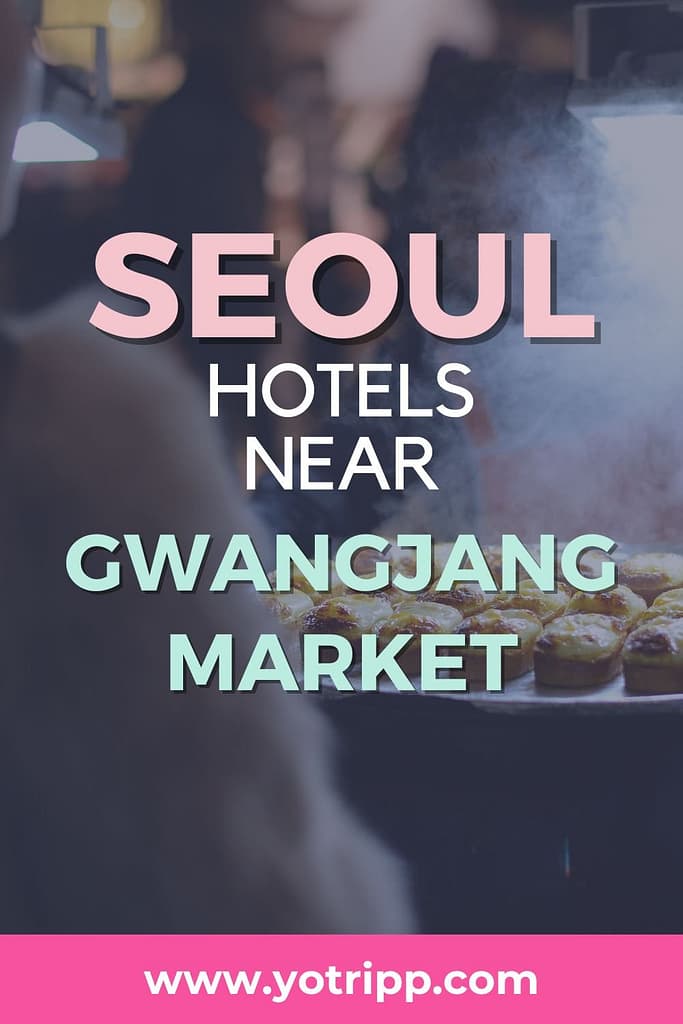
Pin this to your Seoul Pinterest board so you can find this post easily again.

